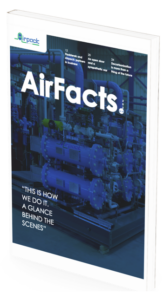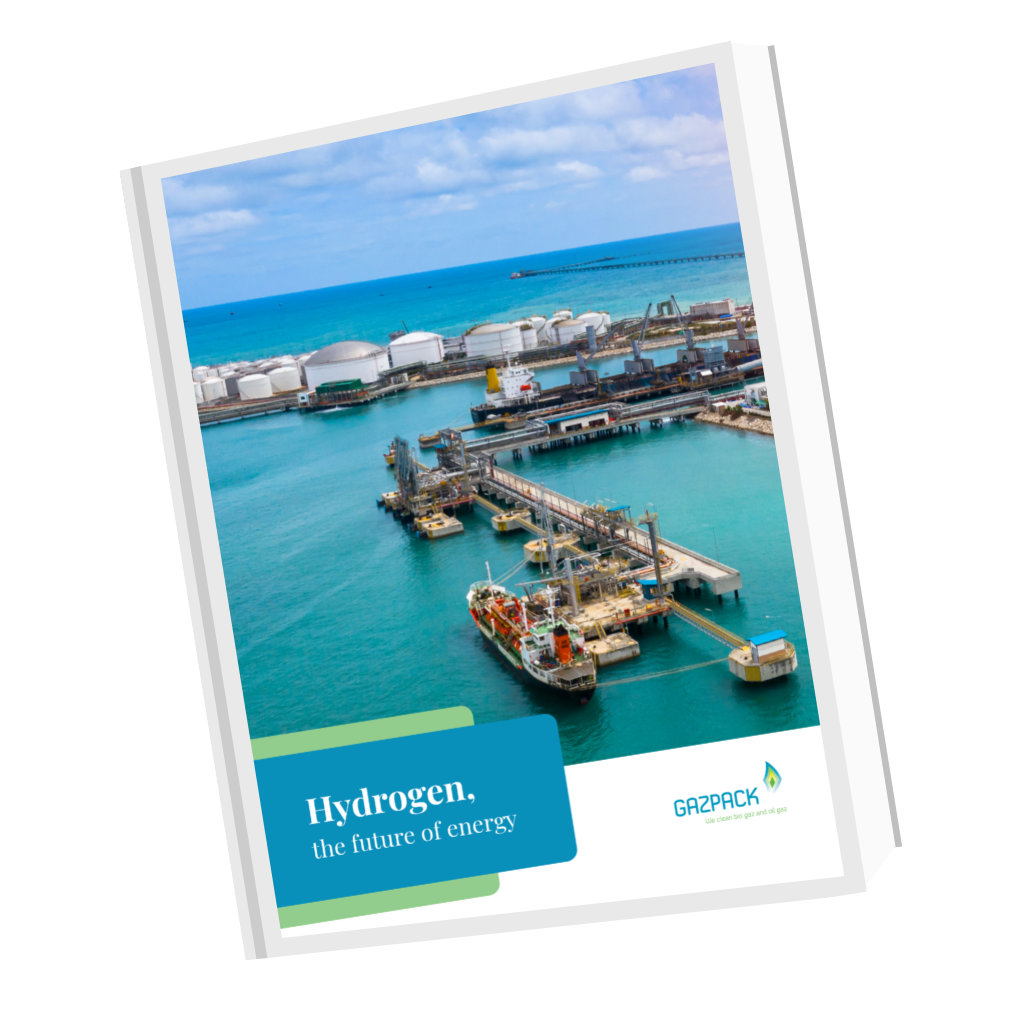Biogas from waste
Looking to explore the world of biogas processing and handling solutions? Get instant access to our documents about biogas technology.
One of the most consistently growing industries over the last few decades is that of waste management. In terms of workforce, earnings and markets, companies engaged in this business show no signs of pulling back. For sure, the industry expands because waste proliferates. Dealing with it seems a never-ending challenge. Hopeful signs, however, relate to the potential of waste as a resource. Biogas from waste can be captured and converted to electrical power. The net effect is two-fold: less waste for landfills and more energy for economic growth, quality of life and even national security. Technology has enabled this development.
What Qualifies as “Waste”?
Yes, time, money and potential can all get wasted. Yet the waste that costs so much to manage is known as solid waste. According to the U.S. Environmental Protection Agency, solid waste is best defined by the 1976 Resource Conservation and Recovery Act (RCRA). Under RCRA, solid waste is “any garbage or refuse, sludge from a wastewater treatment plant, water supply treatment plant, or air pollution control facility and other discarded material, resulting from industrial, commercial, mining, and agricultural operations, and from community activities. Nearly everything we do leaves behind some kind of waste.” EPA clarifies that solid waste may contain liquid and gaseous elements as well.
Waste Management in the United States
U.S. municipalities generated 88.1-million tons of solid waste in 1960. By the year 2017, that generation reached 267.8-million tons. The population expansion and development of new industries — among other culprits — can claim credit for this. By the same token, sound conservation measures may be the reason this figure is not higher. To this point, the number of landfills in the country dropped from 6,326 in 1990 to 1,269 in 2017. A prime factor here is recycling: 6.4 percent of solid waste was recovered for recycling in 1960; by 2017, 35.2 percent was recovered. Clearly, progress is evident over the decades. Still, managing waste continues to be a major challenge.
What Fills the Landfills?
As mentioned above, solid waste is not strictly solid: liquids and gasses mix with solid materials. This is especially true for landfills. Anaerobic bacteria, i.e. bacteria that lives without the presence of oxygen, emit biogas. This landfill gas, as it is called, possesses a high concentration of methane. Collected properly, this biogas production from waste can generate electricity for homes, vehicles and machinery. Using a methane gas recovery system, U.S. cities extracted 270 billion cubic feet of landfill gas in 2018 from 352 different landfills. When burned, this biogas from waste generated 11-billion kilowatt-hours of electricity, constituting 0.3 percent of electricity nationally. This from trash to gas biomass energy also reduces the total landfill density.
So much garbage and refuse is organic in nature: banana and potato peels; egg shells and carrot stems; meat drippings and trimmed fat, to name just a few common waste products. The solar energy inherent in these materials is what yields the biogas of which methane (CH4) and carbon dioxide (CO2) are the primary constituents. Biogas production from organic waste can happen in the landfill, which serves as an anaerobic organic waste digester, keeping out oxygen and letting the bacteria do their work. Because methane is a flammable pollutant, precise technologies are required for its collection.
Yet biogas generation from food waste can happen in smaller settings. Modestly scaled anaerobic digesters can serve households as well. This sort of compost and food waste biogas plant can significantly cut electric bills.
Old MacDonald Has More than a Farm
The waste from agricultural operations is a perfect example of organic matter. From rotting silage to livestock manure, farms produce no shortage of substrate (raw material) for biogas production from agricultural waste. On-farm anaerobic digesters can receive the manure of cattle, swine or poultry and produce enough methane — and therefore electricity — to power the farm and have a surplus to sell to a public utility. Not only are substantial energy savings realized. but greenhouse gas emissions are slashed and odors are abated, as well.
Not only does anaerobic digestion create energy resources, the ash left after the biogas from agricultural waste is collected serves as a potent fertilizer for crops. Effluent from dairy cattle, for instance, demonstrates a higher nitrogen content than untreated manure does. Crops high in solar energy, like maize, make silage that is also an effective substrate for biogas from vegetable waste.
A “Sewer” Path to Power
Water treatment facilities are now getting into the electricity business. The organic substances found in sewage sludge are converted anaerobically to hydrogen, alcohol, CO2 and fatty acids. In the second stage, sewage biogas, consisting mainly of CH4 and CO2, is extracted. The biogas from sewage at one such facility in Austria generates 1.4 gigawatt-hours of electricity every year. Meanwhile, in Saitama Prefecture, Japan, another digester operation powers 5,000 homes as well as automobiles, all the result of biogas production from sewage sludge.
Other Substrates for Biogas
Household digester systems are successful at producing biogas from grass clippings and other dead flora. In addition, biogas from algae is promising, though research continues. Other areas of ongoing study include seaweed biogas. Though the amount of yielded methane from human feces is considered modest compared to that of livestock manure, there is a human waste biogas plant in India — doubtless not the only place — that better sanitizes its water systems through its use of digesters.
Biogas Production sources:
Biogas Production from Organic Waste
The organic waste digester plays a crucial role in sustainable energy production, by enabling biogas production from organic waste. This innovative technology is capable of breaking down various types of organic waste, even plant waste, into a valuable source of biogas. Biogas from plant waste is a promising pathway towards a more sustainable and circular economy, transforming a waste product into a beneficial resource. Furthermore, the digester is not limited to plant waste; it also supports biogas generation from biodegradable waste in general. This process opens up an extensive range of possibilities for waste recycling and energy production, adhering to eco-friendly practices.
Biogas Production from Agricultural Waste
The use of an agricultural waste digester allows for the effective conversion of agricultural biomass into a valuable source of renewable energy. It enables biogas production from agricultural waste, offering an ecological and practical solution to the waste management issue often encountered in farming and agricultural operations. The resulting biogas from agricultural waste provides a sustainable alternative to traditional fossil fuels, promoting a lower carbon footprint. This method of agricultural biogas production is an important aspect of the circular economy, transforming waste products into energy resources, and demonstrating how agricultural practices can adapt to meet environmental sustainability targets.
Biogas Production from Fruit and Vegetable Waste
Turning vegetable and fruit biomass into a valuable source of energy is now possible with the use of a vegetable waste digester. This efficient system aids in biogas production from fruit and vegetable wastes, transforming what would have been discarded into a sustainable energy source. This process not only helps in managing and reducing waste but also contributes to renewable energy production. The resulting biogas from vegetable waste provides a valuable way of repurposing organic matter, demonstrating the potential in every aspect of our consumption cycle to contribute to sustainability and a cleaner environment.
Biogas Production from Food Waste
Harnessing food waste biomass in a food waste biogas plant provides a sustainable solution for the ever-present challenge of food waste management. It allows for effective biogas generation from food waste, transforming discarded food into a viable energy source. The process involves the use of a food waste digester, which breaks down the organic matter in food waste and produces biogas. This food waste to biogas conversion process is not only a significant step towards reducing landfill waste, but also contributes to the generation of renewable energy, thus playing a pivotal role in a sustainable, circular economy.
Biogas Production from Sewage Sludge
In the context of a sewage biogas plant, the potential of sewage biomass as an energy resource is fully harnessed. The plant uses a sewage digester to break down organic matter present in sewage, facilitating biogas production from sewage sludge and water. The resulting biogas from sewage presents a sustainable and renewable form of energy, turning waste into wealth. Additionally, the use of a sludge digester in wastewater treatment goes beyond energy generation, as it significantly contributes to the sanitation and cleanliness of water resources. This process of deriving biogas from sewage sludge and water is an excellent example of a circular economy model, where waste resources are effectively converted into energy.
Biogas Production from Algae
The potential of algae biomass as a source of renewable energy is being increasingly recognized. The use of an algae digester enables biogas production from algae, transforming this abundant and renewable resource into a clean and sustainable form of energy. This technology not only reduces reliance on fossil fuels but also helps in managing and reducing the biomass of algae, which can often grow excessively in certain water bodies. The resulting biogas from algae is a testament to the versatility of biogas production sources, underlining the value of exploring all possible organic inputs for a greener and more sustainable future.
Biogas Production from Grass
Grass biomass, including grass clippings, can be a significant source of biogas when harnessed correctly. By utilizing a grass digester, it’s possible to transform these waste products from landscaping and lawn care into a valuable source of renewable energy. This technology facilitates biogas from grass, turning a readily available and frequently discarded resource into a viable energy solution. Not only does this process reduce waste, but it also contributes to the diversification of energy sources, showcasing the untapped potential of everyday waste in fostering a sustainable future.
Biogas Production from Seaweed
Harnessing seaweed biomass for the generation of biogas has shown promising potential in the renewable energy sector. Through the use of a seaweed digester, it is possible to extract biogas from the organic matter present in seaweed, transforming it into a clean and sustainable energy source. The resulting seaweed biogas is a testament to the diversity of renewable energy sources available in our environment.
Biogas Production from Landfill
Landfill gas cleaning is a critical aspect of managing waste dumps and contributes significantly to minimizing environmental pollution. This process involves the use of a landfill digester, a technology designed to extract and purify the gases released from decomposing waste. The landfill biomass digester breaks down the organic matter present in the landfill, reducing the emission of harmful gases, and converting it into biogas. This biogas can then be used as a renewable source of energy, effectively turning waste management into a productive activity contributing to a more sustainable and circular economy.
Biogas Production from Human Waste
The potential of human waste biomass as an energy resource is being increasingly recognized. A human waste biogas plant uses a human waste digester to break down organic matter present in human waste, transforming it into a clean and renewable source of energy. This innovative approach not only aids in managing human waste effectively but also contributes to the production of biogas, a valuable alternative to traditional fossil fuels. The conversion of human waste into biogas signifies a key step towards achieving a more sustainable and circular economy, where waste resources are effectively turned into energy.
In Summary
Biogas from waste holds promise for a world where electric power is in high demand and biomass is highly available. As anaerobic digester technology improves, the substrates from which the biogas is collected will expand in number. This is good news for public works, public health, economic growth and environmental sustainability.




